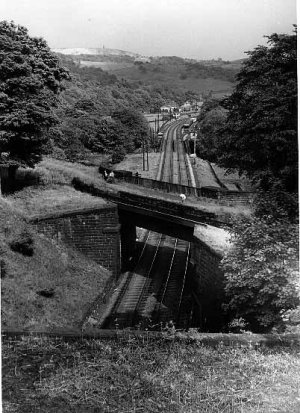Whatstandwell Bridge on the Cromford Canal, when the towpath
was meant to be used by horses for towing.
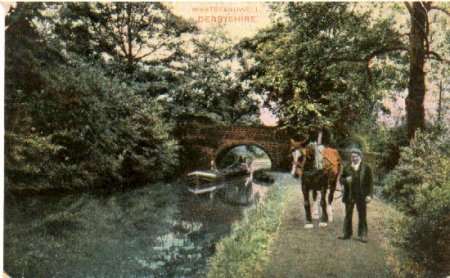
In an obviously posed photograph, W Dawes & Son's boat "Shamrock"
waits to be unloaded at Cromford Wharf. The large pieces of coal from
previous deliveries have been individually man-handled off the boats
and neatly stacked on the edge of the wharf. Horses and carts wait on
the right to distribute the coal locally. In twelve months during
1900-1901, Dawes brought 176 boatloads of coal to Cromford, almost
all from Hartshay.
[Credit Friends of Cromford Canal]
See 1881
and 1891 Census.
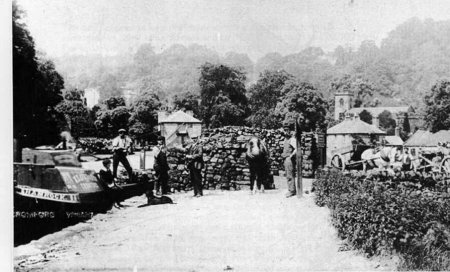
This view from the hillside above the A6 shows the Derwent or Wigwell
Aqueduct with leawood Pump House to it left and the canal snaking away
past the Wharf Shed towards the railway workshops. The broad elliptical
span of Jessop's Aqueduct takes the canal across the Derwent and the
massive abutments either side can just be made out. On the outside of
thesewere two smaller arches for fishermen and cattle. At the far right
of the Aqueduct is the junction with the Leawood Arm, which followed
the river bank then headed away towards the hat factory and Smedley's
mills, seen in the middle distance above the Aqueduct.
[Credit Friends of Cromford Canal]
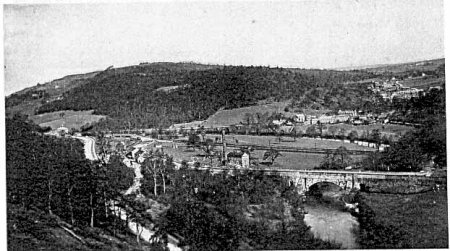
The tithe map of 1841 shows a wharf here at Whatstandwell on the opposite,
northern side of the canal to Eden House. In 1945 one of the last boats
was tied up there, still floating and apparently in good condition, but
looking somewhat neglected. As the local Canal Inspector Edward Sampson
lived nearby until his retirement in 1958, this was a convenient and
safe place to tie up the boat.
[Credit Friends of Cromford Canal/Fred Copeland]
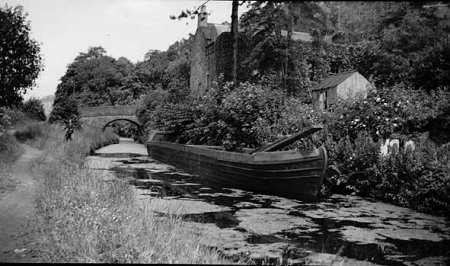
Aqueduct Cottage in autumn 1905, photographed by William Henry Stockwell.
The small wooden swing bridge over the entrance to the Leawood Arm can be
seen crossing the narrows where once were housed stop gates to control the
water level in the side arm and to prevent loss of water from the main
canal.
[Credit Friends of Cromford Canal/Julie Simpson]
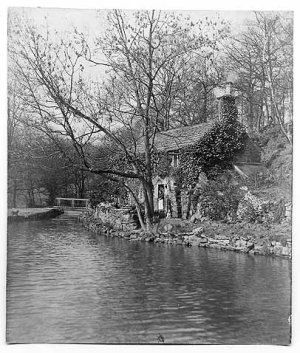
Cromford Canal
Hugh Potter, Archivist of
The Friends of Cromford Canal,
has allowed me to
use these these images and the accompanying text from his book
"The Cromford Canal" ISBN 0-7524-2802-0, published by Tempus
Publishing Limited. This excellent paperback has 212 photos each with
text. Thanks Hugh.
See also Census entries for canal workers.
See also Census entries for canal workers.
The name of Wheatcroft was associated with the Cromford Canal for
over 150 years. In fact this sign, or possibly a replica, was still
in place at Cromford Wharf in 2003, over 200 years after the canal
was opened. Seen here in the early years of the twentieth century,
Nathaniel Wheatcroft's staff are well turned out for the photographer.
[Credit Friends of Cromford Canal/Alan Swift]
See 1841,
1851,
1861,
1871 and
1881 Census.
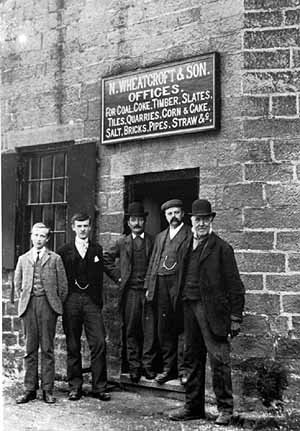
Mrs Ann Eaton sits outside Aqueduct cottage, where she lived for many years,
with one of her daughters, Mrs Violet Farnsworth, and her two children
Henrietta and Arthur. They are sitting on the steps from which they
drew washing from the canal. The cottage has no mains services.
[Credit Friends of Cromford Canal/Ivy Turberville]
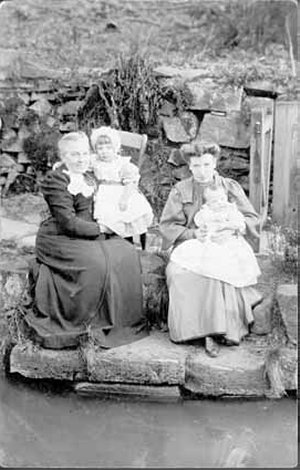
Roger Jennens |
This unusual view of the cast iron aqueduct carrying the canal over the
Midland Railway was taken from on top of the adjacent Leawood railway
tunnel. Beyond the canal, the line crosses the Derwent before reaching
the 'real' High Peak Junction, where the Cromford & High Peak Railway
joined the main line from 1853. The canal to the right contours round
the spur of land, Lea Wood, through which the railway tunnels. There
was a second aqueduct as the track emerged at the other end. On top
of the distant quarry face is Crich Stand, the memorial to the
Sherwood Foresters who died in the First world war.
[Credit Friends of Cromford Canal/Frank Rodgers]
